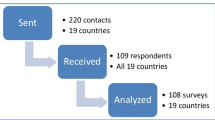Abstract
Purpose
Febrile neutropenia (FN) remains a common and dangerous complication of cancer treatment. Guidelines from the Infectious Disease Society of America urge initiating antibiotics within 2 h of presentation. We reviewed our institution’s performance to identify areas of needed improvement and to design performance improvement steps.
Methods
FN management was deconstructed into discrete tasks. Experienced practitioners estimated appropriate time allowance for each task. Cycle time analysis data on a baseline cohort (baseline group) identified causes and loci of delay. Based on these data, new processes to bypass roadblocks for timely therapy were introduced. Performance monitoring continued as these changes were implemented (the transitional group) and for 20 months thereafter (the post-intervention group).
Results
Sixty-nine episodes of FN were identified. Ten distinct improvement steps were implemented. Median time to antibiotics was reduced from 252 min, to 188 min and 118 min for the baseline, transitional, and post-intervention groups, respectively (p = 0.0002 for the baseline vs. the post-intervention group comparison). Variability was reduced with the inter-quartile range falling from 174 min (baseline) to 65 min (post-intervention). Despite improvement, there were persisting episodes of delays, due to competing priorities from other patients or decisions to postpone infusion of antibiotics until patients had been admitted. Standardized order sets eliminated improper antibiotic choices as a source of error.
Conclusions
Improvements in the management of FN can be accomplished and sustained by the focused study of performance of individual tasks, the design of streamlined processes by practitioners, and the ongoing review of performance with feedback to clinical departments.

Similar content being viewed by others
References
Caggiano V, Weiss RV, Rickert TW, Linde-Zwirble WT (2005) Incidence, cost, and mortality of neutropenia hospitalization associated with chemotherapy. Cancer 103:1916–1924
Kuderer NM, Dale DC, Crawford J, Cosler LE, Lyman GH (2006) Mortality, morbidity and cost associated with febrile neutropenia in adult cancer patients. Cancer 106:2258–2266
Talcott JA, Siegel RD, Finberg R, Goldman L (1992) Risk assessment in cancer patients with fever and neutropenia: a prospective, two-center validation of a prediction rule. J Clin Oncol 10:316–322
Freifeld AG, Bow EJ, Sepkowitz KA et al (2011) Clinical practice guideline for the use of antimicrobial agents in neutropenic patients with cancer; 2010 update by the Infectious Disease Society of America. Clin Infect Dis 52(4):e56–e93
Kumar A, Roberts D, Wood KE et al (2006) Duration of hypotension before initiation of effective antimicrobial therapy is the critical determinant of survival in human septic shock. Crit Care Med 34:1589–1596
Klastersky J, Paesmans M, Rubenstein EB et al (2000) The multinational association for supportive care in cancer risk index: a multinational scoring system for indentifying low-risk febrile neutropenic patients. J Clin Oncol 18:3038–3051
Clarke RT, Warnick J, Stretton K, Littlewood TJ (2011) Improving the immediate management of neutropenic sepsis in the UK: lessons form a national audit. Brit J Haematol 153:773–779
Burry E, Punnet A, Mehta A, Thull-Freedman J, Robinson L, Gupta S (2012) Identification of Educational and infrastructural barriers to prompt antibiotic delivery in febrile neutropenia: a quality improvement initiative. Pediatr Blood Cancer 59:431–435
Szwajcer D, Czaykowski P, Turner D (2011) Assessment and management of febrile neutropenia in emergency departments within a regional health authority-a benchmark analysis. Curr Oncol 18:280–284
Nirenberg A, Mulhearn L, Lin S, Larson E (2004) Emergency department waiting times for patients with cancer with febrile neutropenia: a pilot study. Oncol Nurs Forum 31:711–715
Wu AW, Kipshutz AKM, Pronovost PJ (2008) Effectiveness and efficiency of root cause analysis in medicine. JAMA 299:685–687
Zuckermann J, Moreira LB, Stoll P, Moreira LM, Kuchenbecker RS, Polanczyk CA (2008) Compliance with a critical pathway for the management of febrile neutropenia and impact on clinical outcomes. Ann Hematol 87:139–145
Baltic T, Schlosser E, Bedell MK (2002) Neutropenic fever: one institution’s quality improvement project to decease time from patient arrival to initiation of antibiotic therapy. Clin J Oncol Nurs 6:337–340
Acknowledgments
The authors thank Professor Charles Mylander for expert statistical analysis and Jeanne Morris RN for assistance with data acquisition.
Conflict of interest
The authors declare no conflicts of interest. No outside funding was received for this study. The authors retain control of all primary data which is available to review.
Author information
Authors and Affiliations
Corresponding author
Rights and permissions
About this article
Cite this article
Meisenberg, B., Clemons, J., Ness, J. et al. Improving hospital performance in the treatment of febrile neutropenia. Support Care Cancer 23, 371–375 (2015). https://doi.org/10.1007/s00520-014-2377-y
Received:
Accepted:
Published:
Issue Date:
DOI: https://doi.org/10.1007/s00520-014-2377-y




